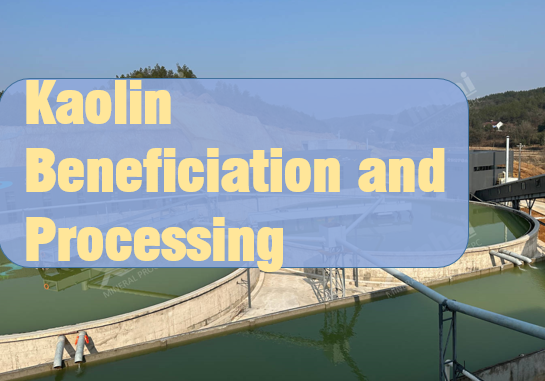Kaolin Beneficiation and Processing: Transformation from Ore to "Universal Stone"
2025-07-17 Xinhai (1079)
2025-07-17 Xinhai (1079)
If you have any questions, please contact us through the following ways, we will give you more and better assistance!

Kaolin, a silicate mineral containing aluminum known as the "universal stone", occupies an irreplaceable position in industrial and agricultural fields due to its fine particles, stable chemical properties, and diverse characteristics. It also has many aliases such as Guanyin soil, pottery clay, and white mud. It has both plasticity and high-temperature resistance, and wet soil can be shaped and remain unchanged for a long time. These characteristics lay a solid foundation for its wide application.
In terms of classification, the diversity of kaolin is remarkable. According to mineralization, it can be divided into three major categories: weathering type, hydrothermal alteration type, and sedimentary type, each containing different subtypes; according to texture, plasticity, and sand content, it is divided into hard, soft, and sandy kaolin. There are more than 700 kaolin mining sites in China, with proven reserves of 3 billion tons, but the mining sites are scattered and the grades are different. In particular, coal-measure kaolin is difficult to mine due to its associated characteristics, which highlights the importance of beneficiation and processing.

Raw kaolin ore often contains impurities such as quartz, feldspar, iron-titanium oxides, and organic matter, which directly affect its whiteness and purity. Therefore, beneficiation and processing are key to unlocking its value. At present, beneficiation and processing methods are mainly divided into physical, chemical, and physicochemical methods. Various methods have their own focuses, and flexible combination can achieve the best results.
Physical methods are the basic means of beneficiation. The water medium flotation method uses the differences in floating and sinking speed and solubility of minerals in water to easily remove coarse impurities such as quartz, with simple operation and low cost; the classification method separates feldspar and quartz according to particle size or density through vibrating screens, hydrocyclones and other equipment to improve purity; magnetic separation technology precisely removes weakly magnetic coloring impurities such as iron and titanium by means of magnetic force, which is an efficient way to remove iron; ultra-fine grinding refines kaolin through grinding, high-pressure extrusion or air flow crushing to meet the high fineness requirements of papermaking, plastic and other industries.
Chemical methods further improve kaolin quality. Flotation removes colored impurities based on the differences in physical and chemical properties of mineral surfaces, with collectors and regulators, divided into carrier flotation and non-carrier flotation, which can significantly improve whiteness; chemical purification uses acids, alkalis and other reagents to dissolve iron and titanium minerals, and the reductive complexation method has outstanding effects, but environmental impact should be paid attention to; microbial method is an emerging technology, which leaches sulfide impurities through microorganisms such as Acidithiobacillus ferrooxidans, with low cost and little pollution, and has a broad prospect; bleaching integrates magnetic separation, flotation, chemical and other means to focus on whiteness improvement; calcination is crucial for coal-measure kaolin, which can remove carbon, enhance chemical activity, and expand its application in papermaking, cables and other fields; surface modification coats organic coupling agents on kaolin to make it better dispersed in organic materials such as plastics and rubber.
The ultimate goal of these beneficiation and processing technologies is to improve the grade, purity and whiteness of kaolin, transforming it from ordinary ore into a "universal stone". Today, kaolin has penetrated into papermaking, ceramics, rubber, medicine, national defense and other industries, and even played a significant role in high-tech fields such as atomic reactors and space shuttles. In the future, with the continuous innovation of technology, the application potential of kaolin will be further explored, and beneficiation and processing technologies will develop towards more efficient and environmentally friendly directions.